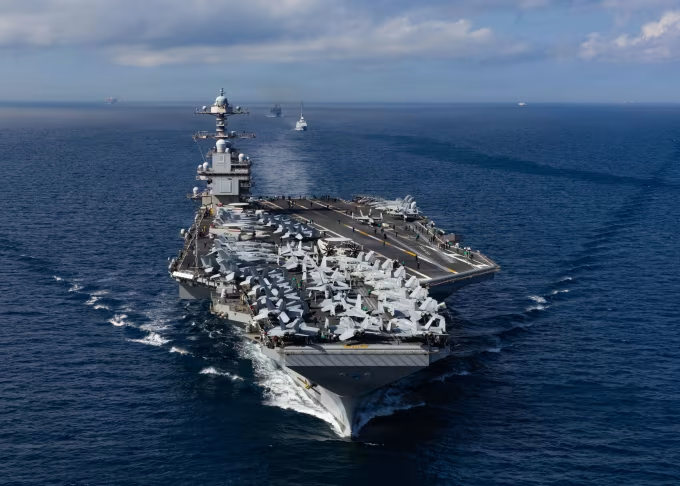The USS Gerald R. Ford, the U.S. Navy’s newest and most technologically advanced aircraft carrier, is being deployed to the Caribbean as the Trump administration intensifies military pressure on Venezuela over alleged drug trafficking. Hailed by the Navy as “the most capable, adaptable, and lethal combat platform in the world,” the Ford represents the pinnacle of American naval engineering and military might.
With a displacement of over 100,000 tons and stretching 1,100 feet (334 meters) in length, the USS Gerald R. Ford is the largest warship ever built for the United States. Commissioned in 2017, it is the first of its class, designed to succeed the 10 Nimitz-class carriers, the oldest of which is scheduled for retirement next year.
The Ford carries a crew of nearly 4,600 personnel, including its air wing—roughly 20% fewer than the Nimitz-class carriers. According to the Navy, this reduction is possible thanks to advanced systems and more efficient operations, which reduce the need for large crews while maintaining high operational capability.
At the heart of the Ford’s power are its two nuclear reactors, whose exact specifications remain classified. The Navy reports that these reactors produce three times the electrical output of those on Nimitz-class carriers. This immense power allows the Ford to operate all of its advanced systems simultaneously and provides the energy needed for cutting-edge technologies like the Electromagnetic Aircraft Launch System (EMALS).
EMALS replaces traditional steam catapults with electromagnetic launchers, enabling the carrier to launch aircraft faster and more efficiently, with greater fuel loads and heavier weapons. This advancement significantly increases the range, payload, and combat effectiveness of the Ford’s air wing.
The Ford also features 11 Advanced Weapons Elevators, which use electromagnetic motors instead of hydraulic systems. These elevators move munitions quickly and safely from magazines below deck to the flight deck, ensuring a higher tempo of operations and faster sortie rates.
Landing operations on the Ford are supported by the Advanced Arresting Gear (AAG). This digitally controlled system catches an aircraft’s tailhook upon landing, allowing for increased landing rates and reduced energy consumption compared to older systems. The Ford’s flight deck is approximately four feet wider than Nimitz-class carriers, and its “island” superstructure is smaller and set farther back, providing more space for safe and efficient aircraft handling.
The carrier’s offensive strength is anchored by its F/A-18 fighter jets. These twin-engine Boeing aircraft are versatile, capable of carrying air-to-air, air-to-ground, and anti-ship missiles, as well as laser-guided bombs. They have a maximum combat range of 1,250 miles (2,011 kilometers). In addition to fighters, the Ford deploys electronic warfare aircraft, airborne early warning and control planes (AEW&C), cargo and passenger aircraft, and helicopters, making it capable of executing a wide range of military operations.
However, the USS Gerald R. Ford does not yet carry the Navy’s newest stealth fighter, the F-35C, as modifications to support fifth-generation aircraft are planned for a future maintenance period.
Despite its advanced technology, preparing the Ford for combat deployment was a complex and time-consuming task. Although commissioned in 2017, the carrier did not undertake its first deployment until 2022, as the Navy worked to address technical challenges associated with its advanced systems. Its first combat deployment occurred in 2023, an eight-month cruise that included operations in the eastern Mediterranean following the Hamas-led attacks on Israel on October 7.
The USS Gerald R. Ford is not just a platform for aircraft and missiles; it is a symbol of American technological innovation, strategic flexibility, and military power. Its EMALS, AAG, and advanced weapons elevators allow for faster, safer, and more efficient operations than any previous carrier, giving the U.S. Navy a distinct advantage in modern naval warfare.
The carrier’s deployment to the Caribbean is strategically significant. While officially aimed at maritime security and operational readiness, its presence underscores America’s ability to project power rapidly in regions of geopolitical tension. Military analysts note that the Ford’s presence alone serves as a deterrent, signaling the U.S. commitment to protecting its interests and allies in the Western Hemisphere.
Carriers like the USS Gerald R. Ford are more than warships; they are floating symbols of American influence and technological prowess. With its advanced aircraft, state-of-the-art launch and recovery systems, and rapid munitions handling capabilities, the Ford sets new standards for efficiency, lethality, and operational flexibility.
Its deployment to the Caribbean demonstrates the U.S. Navy’s readiness to respond to crises anywhere in the world. Whether countering drug trafficking, supporting allies, or engaging in high-stakes military operations, the Ford represents a combination of power projection, advanced technology, and strategic deterrence unmatched by any other naval vessel.
Ultimately, the USS Gerald R. Ford is more than just the Navy’s largest aircraft carrier. It is a platform for modern warfare, innovation, and strategic influence. Its deployment marks a new chapter in U.S. naval history, showcasing America’s ability to maintain dominance at sea and reinforcing the nation’s role as a global military power. As the Ford sails into the Caribbean, it sends a clear and unmistakable message: the United States Navy is capable, prepared, and ready to respond to any threat, anywhere in the world.

